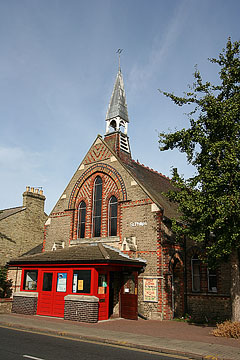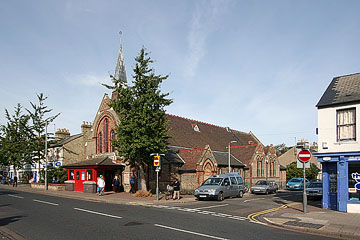So, what did £2,000 buy you in 1890? If you were so minded, you could build a decent-sized church for that money. You couldn't have expected much in the way of detailing: a few red and black bricks to add accents to the dull yellow Cambridge bricks you'd be forced to use otherwise, and a small fleche at the west end (bell costs extra), and that's about it. Don't expect any stained glass, and you'll have to roof your nave with clay tiles rather than slate.
I suppose that such economy is to be applauded, but it does leave us with a rather dispiriting result. St Philip's is effectively just a long low hall, with rather desultory transepts (for which read 'small gables half way down the church') and aisles tacked on to the sides. There is a south porch, but it's been bricked up in favour of the western door which opens directly onto the busy pavement of Mill Road. The windows are filled with grimy frosted glass in that swirling pattern beloved of bungalow designers and shower-cubicle manufacturers of the early 90s.
What more is there to say? My curiosity was briefly piqued by a structure on the apex of the roof towards the east end. Was this supposed to support another fleche, or a sanctus bell? Who knows? If you do happen to be out at this end of Mill Road, see what you think. Then, go and buy some olives and pesto from the Italian delicatessen on the other side of the road back towards the railway bridge: much more fulfilling.
A few months later, Mark and I were passing St Philip on a Sunday morning, so I nipped in after their service had finished.
The western end of the nave has been divided into two floors, so one enters by a low-ceilinged reception space. The church itself is mostly plain, though it does have a complicated timber roof with detailing that smacks somewhat of Bavaria.
I would have pottered around longer, but I'm always a bit uncomfortable wandering around a church when the congregation is there to sip tea and speculate about which candlesticks I might want to nap. Not that there are many candlesticks in St Philip, mind: the drumkit in the transept suggests that this is rather an evangelical place.
St Philip is open when in use.

